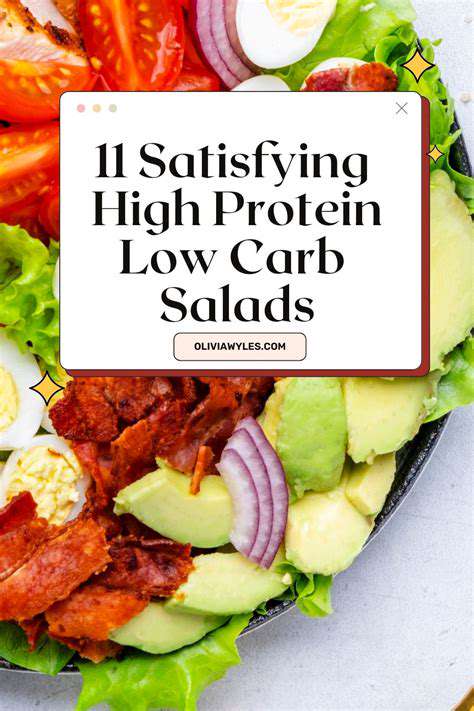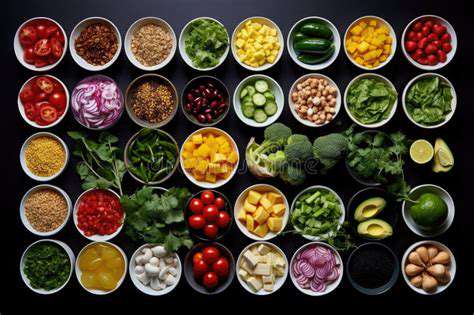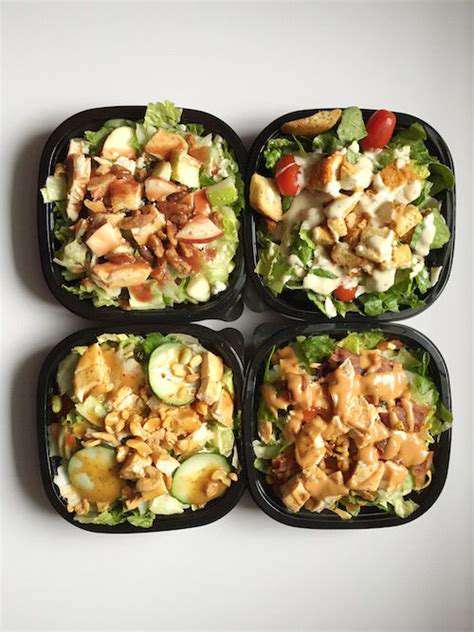Vegetarian Lunch Salads: Fresh and Satisfying
Beyond the Ordinary: Creative Combinations
Stepping beyond the standard lettuce-and-tomato salad can elevate your vegetarian lunch to a culinary experience. Imagine a vibrant mix of roasted vegetables—sweet bell peppers, caramelized onions, and tender zucchini—paired with crunchy chickpeas and a tangy lemon-herb vinaigrette. This combination offers a symphony of textures and flavors, far exceeding the basic salad experience. The roasted vegetables add a depth of flavor that's simply unmatched by raw ingredients, making every bite an adventure.
Another exciting approach is incorporating grains like quinoa or farro. These grains provide a satisfying base for the salad, adding a hearty element to complement the freshness of vegetables and legumes. A salad with quinoa, roasted butternut squash, crumbled feta (if desired), and a balsamic glaze offers a warm and comforting feeling, ideal for a chilly day.
The Power of Protein: Adding Plant-Based Protein
Vegetarian lunches often miss out on the satisfying protein punch that meat provides. However, many plant-based protein sources can easily be incorporated into your salad, transforming it from a light meal to a complete and filling one. Lentils, chickpeas, and beans are excellent choices, offering a robust texture and a substantial amount of protein. Adding these ingredients to your salad creates a meal that keeps you feeling full and satisfied for hours.
Beyond these staples, consider adding tofu or tempeh, which can be marinated and grilled or pan-fried to add a savory depth. This extra protein component ensures your salad provides the necessary nutrients for a productive day.
Flavorful Dressings: Beyond the Basic Vinaigrette
The dressing is often the unsung hero of a salad. A simple vinaigrette, while effective, can sometimes fall short of creating a truly exceptional flavor profile. Experiment with different dressings, such as a creamy avocado dressing, a vibrant tahini dressing, or a tangy lime-cilantro vinaigrette. These dressings not only add flavor but also provide healthy fats and essential vitamins, enhancing the overall nutritional value of your meal.
Don't be afraid to incorporate flavorful ingredients directly into your dressing. A roasted red pepper dressing, for example, adds a smoky depth and a beautiful color to your salad, elevating the entire experience.
Adding Texture and Crunch: The Importance of Variety
A truly satisfying salad goes beyond just taste; it needs a delightful array of textures. Incorporating a variety of ingredients with different textures—from the crisp crunch of cucumbers and bell peppers to the satisfying chewiness of cooked grains—will make your salad more appealing and engaging. Adding nuts, seeds, or even crispy fried onions provides a delightful textural contrast that elevates the overall eating experience.
Think about the different textures that you can create. The combination of soft avocado, crunchy croutons, and juicy cherry tomatoes creates a wonderful harmony of textures that will make your salad a true delight.
Presentation Matters: Making Your Salad Appealing
Beyond the ingredients, the way you present your salad can significantly impact your enjoyment. Take the time to arrange your ingredients artistically on a plate. Use different colors and shapes to create a visually appealing masterpiece. A beautifully presented salad not only looks good but also encourages you to savor each bite and appreciate the effort you put into your meal. Using attractive serving dishes and garnishing with fresh herbs can enhance the aesthetic appeal of your salad and make it a more inviting and satisfying experience.
Experiment with different plating styles. Layering ingredients in a tiered fashion, arranging vegetables in a decorative pattern, or using colourful bowls can all make a difference in how your salad looks and feels when you eat it.
Protein Powerhouses for a Satisfying Salad

Protein Powerhouses for Muscle Growth
Protein is essential for building and repairing tissues, including muscles. Consuming adequate protein is crucial for athletes and individuals looking to gain muscle mass, as it provides the building blocks for new muscle fibers. A diet rich in high-quality protein sources can significantly contribute to muscle growth and strength gains. Protein synthesis, the process of building new muscle tissue, is directly influenced by the availability of amino acids, the fundamental components of protein. Choosing lean protein sources like poultry, fish, beans, and lentils can ensure you're getting the necessary amino acids for optimal muscle growth.
Furthermore, protein plays a vital role in maintaining muscle mass, especially as we age. Maintaining adequate protein intake is crucial for preserving muscle function and preventing age-related muscle loss, a condition known as sarcopenia. Regular consumption of protein-rich foods supports the body's ability to repair and rebuild muscle tissue after exercise or injury. This continuous process of muscle repair and growth is essential for overall physical health and well-being.
Protein's Role in Satiety and Weight Management
One of the significant benefits of incorporating protein into your diet is its ability to promote satiety. High-protein foods often take longer to digest compared to carbohydrates or fats, leading to a feeling of fullness that can help control appetite and prevent overeating. This sustained feeling of fullness can be particularly beneficial for individuals looking to manage their weight or lose excess body fat.
By increasing the protein content of meals, you can help regulate blood sugar levels. This is because protein slows down the absorption of glucose into the bloodstream, preventing significant spikes in blood sugar after eating. This effect can be helpful in preventing or managing conditions like type 2 diabetes. Protein also plays an important role in boosting metabolism, which in turn can support weight loss efforts. Protein-rich foods require more energy to digest than other macronutrients, contributing to a higher metabolic rate. This increased metabolic rate can help burn more calories throughout the day.
Moreover, a higher protein intake can help preserve lean muscle mass during weight loss. This is important because muscle tissue burns more calories than fat tissue. By maintaining muscle mass, you can support a higher metabolic rate, making weight loss more sustainable and effective in the long run. Consuming sufficient protein during weight management can help prevent the loss of valuable muscle tissue and ensure a healthier and more balanced body composition.

Beyond the Bowl: Creative Salad Variations

Beyond the Basic: Elevating Your Salad Game
Salads, often perceived as a simple side dish, hold immense potential for culinary creativity. Transforming a basic salad into a vibrant and flavorful experience involves exploring a wider range of ingredients and textures. Beyond the lettuce and tomatoes, lies a world of possibilities waiting to be discovered. Experiment with different greens, from crisp romaine to peppery arugula, and embrace the diverse flavors available from various vegetables and fruits.
Ingredient Innovation: A Symphony of Flavors
Expand your ingredient horizons beyond the usual suspects. Incorporate roasted vegetables like bell peppers or sweet potatoes for added depth of flavor and a delightful textural contrast. Consider incorporating nuts, seeds, or dried fruits for a satisfying crunch and a boost of healthy fats. A sprinkle of toasted sesame seeds or slivered almonds can elevate the taste and aesthetic appeal of your salad significantly.
Dressing Delights: Beyond the Vinaigrette
Don't limit yourself to traditional vinaigrettes. Explore a world of flavorful dressings, from creamy avocado ranch to tangy lemon-herb dressings. The right dressing can transform a simple salad into a culinary masterpiece. Experiment with different flavor combinations, such as a honey-mustard vinaigrette or a spicy sriracha-lime dressing. Consider homemade dressings for a personalized touch.
Protein Power: Adding Substance to Your Salad
Incorporating protein into your salad elevates it from a light meal to a satisfying and complete one. Grilled chicken, shrimp, or tofu can add a substantial protein boost. Lean meats, fish, or beans can also provide the necessary protein and fiber. Choose proteins that complement the flavors of your chosen vegetables and dressing.
Texture Twists: A Culinary Adventure
Adding a variety of textures is key to a truly satisfying salad experience. The combination of crisp greens, soft fruits, crunchy nuts, and chewy grains creates a delightful textural journey. Consider incorporating cooked quinoa or farro for a hearty base, or try adding cooked chickpeas for a satisfying protein and fiber boost.
Presentation Perfection: A Visual Feast
The presentation of your salad is as important as the taste. Arrange your ingredients thoughtfully, creating visually appealing patterns and colors. Use attractive serving dishes and garnishes to add a touch of elegance. A beautifully presented salad not only looks appealing but also enhances the overall dining experience.
Beyond the Meal: Salad as a Healthy Snack
Salads aren't just for dinner. They make excellent healthy and flavorful snacks. Pack a colorful salad for a quick and nutritious lunch or a satisfying mid-afternoon snack. Using fresh, seasonal ingredients and healthy fats will make your salad a perfect choice for a light meal or a quick bite. Choose ingredients that provide both taste and nutritional benefits.
- Dairy Free Desserts: Creamy Vegan Ice Cream Recipe
- Sourdough Starter Maintenance: Keeping It Alive and Active
- Baking Bread Machine Recipes: Effortless Baking
- Storing Dairy Products Properly: Extend Freshness
- Low Sugar Baked Goods for Diabetics: Smart Choices
- Understanding Healthy Hydration: Beyond Water
- Baking Bread from Scratch: Artisan Loaf
- Exploring Caribbean Cuisine: Jerk Chicken and More
- Authentic Japanese Tempura: Crispy and Light
- Discovering Polish Cuisine: Pierogi and Kielbasa
- Authentic Chinese Dumplings: Filling and Folding
- Kitchen Shelving Ideas: Open and Closed Storage